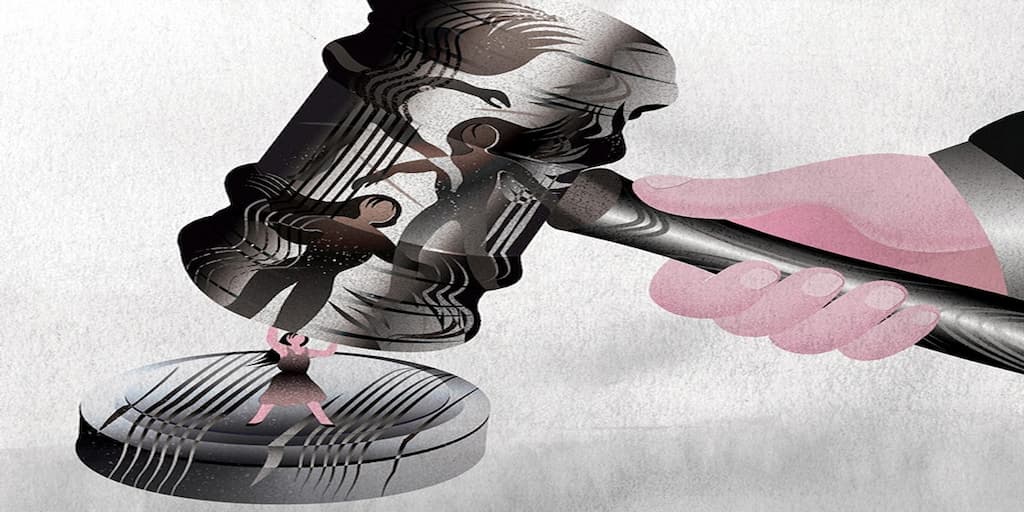How The Two-Finger Test Perpetuates Rape Myths Centred Around ‘Honour’

Trigger Warning: This piece contains mentions of sexual violence which may be triggering for readers.
On October 31, 2022 the Supreme Court of India once again condemned the use of the two-finger tests in rape trials. In an appeal against an order of acquittal by the Jharkhand High Court of a person accused of rape and murder (by setting the victim on fire), the court called the test ‘regressive’ and ‘invasive’.
“This so-called test has no scientific basis and neither proves nor disproves allegations of rape. It instead re-victimizes and re-traumatizes women who may have been sexually assaulted, and is an affront to their dignity. The “two-finger test” or pre vaginum test must not be conducted,” the court noted.
The court reiterated the 2014 guidelines of the Ministry of Health and Family Welfare which states that the two-finger test should not be conducted in cases of sexual violence and the hymen should be treated like any other genital part while documenting the findings of a physical examination.
The court, in fact, held that a person who conducts the test while examining a survivor shall be guilty of misconduct.
Previously too, in the Lilu @ Rajesh v. State of Haryana case, the Supreme Court had found that rape survivors are entitled to legal recourse that does not retraumatise them or violate their physical or mental integrity and dignity.
Indian laws on evidence recognise the three kinds of evidences that can be relied on in proving allegation of rape-
- Victim’s own testimony
- Medical evidence
- Other witnesses and circumstantial evidences
In this piece, we look at how each of these is subject to stereotypes for victims in search of justice.
Victim’s Testimony
A victim’s testimony is the most important evidence in rape trials. Law provides that an allegation of rape can be sustained on a victim’s uncorroborated evidence, i.e. on her sole testimony, even if there is no other material available. A victim’s testimony is strong evidence as long as it stands scrutiny of cross-examination.
However, courts have trusted testimonies only in cases where the victim fits stereotypical perceptions of how an “ideal” rape victim should look and behave, and what her reaction should be to the violence against her. This attitude springs from the courts’ initial struggle to figure out if the survivor should be considered an accomplice or a victim in the rape.
During the trial of rape cases, courts have drawn a deeply troubling comparison between an “Indian woman” and a “western woman”. They have stereotyped that the latter is bold, sophisticated, and sometimes a “gold digger” as opposed to the former who feels “deathless shame” on being raped. Thus, the farther a woman is from this image of an ‘Indian woman’, the less likely she is to be believed in court’s of law.
A victim who is sexually active, drinks, has had multiple partners, is marginalized, or a sex worker or is generally outgoing is less likely to be trusted by courts. Courts seem to have an entire laundry list of how an ideal “Indian woman” responds to rape. Thus, even though a victim’s sole testimony is sufficient to prove the guilt of the accused, survivors often have to additionally prove that they fulfill the gendered expectation of an “ideal” rape victim for their testimony to be trusted.
Question of Caste
The conversation on rape myths cannot happen without centering caste.
In our caste-driven society, a Dalit, Adivasi or Bahujan complainant of sexual violence faces uniquely different violence from dominant caste women. Their testimonies are less likely to be believed based on stereotypes of both caste and gender.
Legal scholar Mrinal Satish finds that in A Textbook of Medical Jurisprudence and Toxicology, referred to as Modi’s standard textbook in legal circles, a distinction is drawn between the ability of a “labour class” (read caste) woman and a “rich or middle class” to “resist” violation. He further finds that this stereotype is being cited in court cases during the assessment of the testimonies of rape victims.
In Tukaram v. State of Maharashtra, a 13-year old tribal girl was not believed by the Supreme Court because of the lack of injuries on her body. The trial court called her a “shocking liar”, a view that persisted up to the Supreme Court. After the judgement, activists wrote an open letter to the then Chief Justice of India protesting the judgement. Caste, however, remained missing from this open letter. Bhanwari Devi’s testimony was also not believed because of similar caste stereotypes, as we said in an earlier analysis in The Gender Files series.
These cases show that law stereotypes Dalit, Adivasi and Bahujan women as neither observing the same rules of shame and honour, nor having the same credentials of a “respectable” woman.
Medical Evidences
Medical evidence is not as strong as a victim’s testimony, yet it has come to dominate rape trials. This is based on the belief that the so-called objective medical evidence can filter out “false” rape cases. This, despite its deeply troubled history of stereotyping rape victims. Pratiksha Baxi calls this heavy reliance on medical evidence “medicalization of consent” whereby the supposed scientific tests are given preference over a woman’s own voice.
Two-Finger Test
The two-finger test involves inserting two fingers into the vagina of the victim to test the presence of the hymen. If this can be done, it is presumed that penile vaginal intercourse or penetration has taken place. If not, it implies that intercourse did not occur and the victim is a “virgin”. This test is based on the presumption that an “intact” hymen will not allow for the insertion of two fingers.
This test is pointless for two reasons.
First, it is junk science. The hymen may break for multiple reasons so its intactness proves nothing. Both the court – in the case related to the October 2022 judgement – and the 2014 guidelines have taken into account the lack of scientific logic in the hymen test.
Yet, medical textbooks go to lengths to explain these tests as a means to establish “virginity”. Legal scholars Mrinal Satish and Durba Mitra point out that Modi’s medical textbook distinguishes between “true” and “false” virgins, a distinction between women who are telling the truth and those not. Modi’s textbook begins with the assertion that women are habituated to lying, and hence “objective” medical tests should be relied on to distinguish between “true” and “false” cases of rape.
Second, and more importantly, rape means lack of consent for a particular act of sexual violence. A woman’s past, whether she is sexually active or not, had multiple partners, just one or none – these issues are irrelevant to determining the guilt of the accused. What matters is whether the victim consented or not to the particular act in question.
As the court in the recent Jharkhand case noted: “Whether a woman is “habituated to sexual intercourse” or “habitual to sexual intercourse” is irrelevant for the purposes of determining whether the ingredients of Section 375 of the IPC are present in a particular case. The so-called test is based on the incorrect assumption that a sexually active woman cannot be raped. Nothing could be further from the truth – a woman’s sexual history is wholly immaterial while adjudicating whether the accused raped her. Further, the probative value of a woman’s testimony does not depend upon her sexual history. It is patriarchal and sexist to suggest that a woman cannot be believed when she states that she was raped, merely for the reason that she is sexually active.”
Based on this realisation the Indian Evidence Act was amended in 2003, and section 155(4) was repealed. Section 155(4) used to allow impeachment of the credit of the victim’s testimony by showing her “immoral character”. (Impeachment of a witness’ credit means proving her untrustworthy.)
This provision was often relied on by the defence to use the sexual history of the victim to establish that she is of “general immoral character” and hence her testimony is unreliable. It is remnant of this sexist logic that allows the two-finger test to be used routinely even now by doctors, courts and lawyers to establish that the victim is “habitual to sexual intercourse’ and hence a habitual “liar”.
Legal scholar Neetika Vishwanath in her research found that despite the 2003 amendment, past sexual history continues to be brought to evidence through reliance on medical examination reports. Even when the report does not record the two-finger test, doctors are brought to the court for “expert evidence” based on junked theories and texts on whether rape was committed.
In the Jharkhand case, the deceased victim, in her dying declaration (accepted as strong evidence under evidence law) had declared that the accused had raped her. But the medical doctor based on this test had testified that she was habituated to sexual intercourse, and hence that there was no evidence of rape. This unscientific and stereotying testimony was relied on by the accused to argue that he is not guilty under section 376 IPC for the offence of rape. The court rejected this testimony of the medical doctor and held that it does not conclusively answer whether the accused raped the deceased or not.
Notably, section 53A of the Indian Evidence Act provides that in trial of rape or attempt to rape victims’s past sexual experience shall not be relevant to the issue of consent or the quality of consent. (These are called rape shield laws)
Lack of Injuries
Explanation 2 of section 375 states that lack of physical resistant shall not be considered as proof of consent in case of rape. Courts too have clarified the same. But historically women have been required to satisfy “the utmost resistance” test, to prove that they physically resisted the violence to establish their allegations.
This again is based on sexist assumption — that it is not possible for a man to rape a healthy woman without her consent. The stereotype here is that an “honourable” woman will fight to the last to save her “honour” and if she resists enough there will be injury marks.
Why Stereotypes Impede Justice
Stereotypes are bad for two reasons: one, they act as a hurdle in ensuring justice to survivors. Instead of actually accounting for the reality of women’s lives and their voices during a trial, these rape myths put additional burden on victims to not just prove their violation but perform its gendered expectations.
These rape myths exist for almost all stages of the criminal justice system — during reporting, trial and finally, sentencing.
Even when the guilt has been proven, the stereotypes play out during the hearing on sentencing. (Hearing on sentencing is the second stage of court proceedings where the quantum of punishment is decided once the accused is found guilty.) Satish, in his analysis of all the cases decided by the Supreme Court and the High Courts of India between 1984 to 2009 (before the 2013 amendment), found that a higher sentence is imposed if the accused is seen to be “taking away” the virginity of a chaste woman. Sentencing, thus, has emerged as a new site of stereotyping.
Courts thus indulge in the construction and reconstruction of rape myths instead of giving reasons as required in the rule of law.
Second, these myths are an affront to the constitutional value of dignity and equality for women. Historically, rape has been a property offence. Before getting the right to vote, women existed in the State’s eyes only as daughters, wives of men i.e. a property of the men, rather than as a legal individual in her own right. Rape trials would be brought by either the husband or the father in terms of damage to their “property” rather than a victim’s right of autonomy, and physical and mental integrity. Stereotypes continue these propertied perceptions of women.
By re-traumatising and re-victimising women, these stereotypes violate women’s rights guaranteed under part-III of the Indian constitution.
Media Reporting
Here it is critical to point to the stereotyping of rape cases in media reports. These often sensationalise the stories of rape by strangers whereas data shows that most of the trials in courts for rape cases involve acquaintances. This creates a perception of home as a safe space whereas in reality home may equally be the site of violence.
[This piece is an explainer based on the scholarship of Mrinal Satish, Pratiksha Baxi, Neetika Vishwanath, Sharmila Rege, Sunaina Arya, Aakash Singh Rathore. Author is thankful to all of them for their scholarship.]
We believe everyone deserves equal access to accurate news. Support from our readers enables us to keep our journalism open and free for everyone, all over the world.




